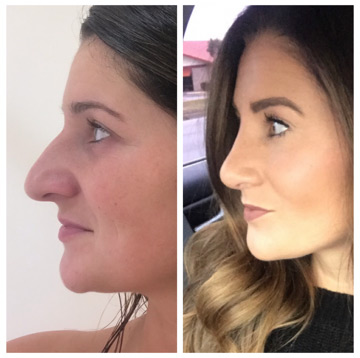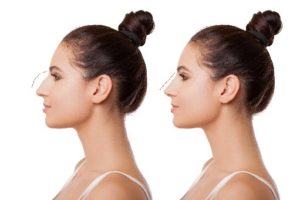The smart Trick of Austin Rhinopasty Surgeon That Nobody is Talking About
Table of ContentsThe 8-Second Trick For Rhinoplasty Austin TxAustin Rhinopasty Surgeon - QuestionsRhinoplasty Austin Tx Can Be Fun For Everyone
Based upon the available area of nasal skin, the cosmetic surgeon picks the area for the bilobed flap, and orients the pedicle. If the problem remains in the lateral aspect of the nose, the pedicle is based medially. If the problem is at the nasal suggestion, or at the nasal dorsum, the pedicle is based laterally.

The external semi-circle specifies the needed length of the two lobes of the skin flap. The inner semi-circle bisects the center of the original wound, and continues throughout the donor skin, establishing limitation measure of the pedicle common to the 2 lobes of the flap. The surgeon then draws 2 lines from the apex of the injury; the very first line drawn is at an angle of 45 degrees from the long axis of the injury, and the 2nd line drawn is at a 90-degree angle from the axis of the wound.
The delineation of each of the 2 lobes of the flap begins and ends at the inner semi-circle, and extends to the external semi-circle, to the point where it intersects its main axis. The width of the very first lobe is approximately 2 mm narrower than the width of the wound; the width of the second lobe is approximately 2 mm narrower than the width of the first lobe.
The wound is deepened, to the nasal skeleton, to accommodate the tissue density of the bilobed flap (rhinoplasty surgeon austin). Technically, cutting the injury, enlarging it, is more effective, and safer, than cutting (thinning) the flap to fit the wound. Weakening the donor website for the second lobe permits closing it mainly; it likewise eliminates excess-skin "dog-ears" at the donor site.
II. Nasolabial flap In the 19th century, the surgical methods of J.F. Dieffenbach (17921847) popularized the nasolabial flap for nasal restoration, for which it stays a foundational nose surgery treatment. The nasolabial flap can be either superiorly based or inferiorly based; of which the superiorly based flap is the more practical rhinoplastic application, due to the fact that it has a more flexible arc of rotation, and the donor-site scar is unnoticeable.
See This Report on Rhinoplasty Surgeon Austin
The blood supply for the flap pedicle are the transverse branches of the contralateral angular artery (the facial artery terminus parallel to the nose), and by a confluence of capillary from the angular artery and from the supraorbital artery in the medial canthus, (the angles formed by the conference of the upper and lower eyelids) (rhinoplasty austin tx).
The nasolabial flap is a random flap that is emplaced with the proximal (near) portion resting upon the lateral wall of the nose, and the distal (far) part resting upon the cheek, which contains the main angular artery, and so is perfused with retrograde arterial circulation. Surgical strategy the nasolabial flap The pedicle of the nasolabial flap rests upon the lateral nasal wall, and is transposed a maximum of 60 degrees, in order to avoid the "bridge impact" of a flap emplaced across the nasofacial angle.
The shape of the skin flap is cut from the injury template produced by the cosmetic surgeon. A cut is made to the flap (without an anaesthetic injection of epinephrine), which then is elevated and oriented, in an inferior-to-superior instructions, in between the subcutaneous fat and the muscle fascia. The cutting continues till the skin flap can be freely shifted upon the nasal defect.
The flap then is bent back (reflected), and can be thinned (cut) under loupe magnification; nevertheless, a nasolabial flap can not be thinned as easily as an axial skin-flap. rhinoplasty austin tx. After the nasolabial flap has been emplaced, the flap donor-site wound is sutured closed. For a wound of the lateral nasal wall that is less than 15 mm wide, the flap donor-site can be closed mostly, with stitches.

Such threats are prevented by advancing (moving) the skin of the cheek towards the nasofacial junction, her explanation where it is sutured to the deep tissues. Furthermore, a narrow injury, less than 1 mm large can be enabled to recover by secondary objective (autonomous re-epithelialisation). III. The paramedian forehead flap The paramedian forehead flap is the premier autologous skin graft for the restoration of a nose, by changing any of the visual nasal subunits, particularly relating to the problems of various tissue density and skin color.
Restricted length is a practical application limitation of the paramedian forehead flap, especially when the patient has a low frontal hairline. In such a patient, a little portion of scalp skin can be consisted of to the flap, but it does have a different skin texture and does continue growing hair; redirected here such mismatching is avoided with the transverse emplacement of the flap along the hairline; yet that part of the skin flap is random, and so risks a higher occurrence of necrosis.
Some Known Facts About Rhinoplasty Surgeon Austin.
Nonetheless, the 2nd phase of the nasal restoration can be performed with the patient under local anaesthesia. Aesthetically, although the flap donor-site scar heals well, it is noticeable, and therefore hard to conceal, especially in men. Nose surgery: A paramedian forehead flap design. Surgical technique the paramedian forehead flap The cosmetic surgeon develops the paramedian forehead flap from a custom-fabricated three-dimensional metal foil design template originated from the measures of the nasal flaw to be corrected.
Later on, the distal Source one-half of the flap is dissected and thinned to the subdermal plexus. The cosmetic surgeon produces a metal foil design template originated from the dimensions of the nasal injury. Using a Doppler ultrasonic scanner, the surgeon determines the axial pedicle of the tissue-flap (composed of the supraorbital artery and the supratrochlear artery), usually at the base, next to the medial eyebrow; the point generally is between the midline and the supraorbital notch.